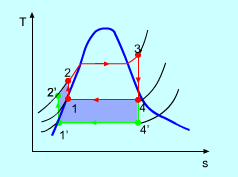| Ch 10. Rankine Cycle | Multimedia Engineering Thermodynamics | ||||||
|
Rankine Cycle |
Reheat | Regeneration | Cogeneration | ||||
| Ideal Reheat Rankine Cycle | Case Intro | Theory | Case Solution |
| Chapter |
| 1. Basics |
| 2. Pure Substances |
| 3. First Law |
| 4. Energy Analysis |
| 5. Second Law |
| 6. Entropy |
| 7. Exergy Analysis |
| 8. Gas Power Cyc |
| 9. Brayton Cycle |
| 10. Rankine Cycle |
| Appendix |
| Basic Math |
| Units |
| Thermo Tables |
| Search |
| eBooks |
| Dynamics |
| Fluids |
| Math |
| Mechanics |
| Statics |
| Thermodynamics |
| Author(s): |
| Meirong Huang |
| Kurt Gramoll |
| ©Kurt Gramoll |
| |
||
| Steam power plants generate most of the electric power in the world. To save fuel, extensive efforts are made to improve the efficiency of the cycle on which steam power plants operate. The general idea is to increase the fluid average temperature during heat addition or decrease the fluid temperature during heat rejection. This section will introduce one of the resulting cycle - the ideal reheat Rankine cycle. | ||
| Methods of Increasing the Efficiency of
the Rankine Cycle
|
||
|
|
There are three ways to increase the efficiency of the simple ideal Rankine cycle. 1. Decreasing the condenser pressure The effect of lowering the condenser pressure on the Rankine cycle efficiency is illustrated on a T-s diagram on the left. Steam exits as a saturated mixture in the condenser at the saturation temperature corresponding to the pressure in the condenser. So lower the pressure in the condenser, lower the temperature of the steam, which is the heat rejection temperature. The blue area is the net work increases due to the decreasing of the condenser pressure. |
|
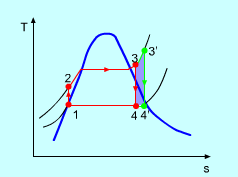 The Effect of Superheating the Steam to a Higher Temperature |
2. Superheating the steam to a high temperature The effect of superheating the steam to a high temperature on the Rankine cycle efficiency is illustrated on a T-s diagram on the left. By superheating the stream to a high temperature (from state 3 to state 3'), the average steam temperature during heat addition can be increased. The blue area is the net work increased due to superheating the steam to a high temperature. |
|
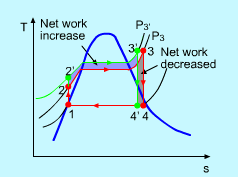 The Effect of Increase the Boiler Pressure |
3. Increasing the boiler pressure The effect of increasing the boiler pressure on the Rankine cycle efficiency
is illustrated on a T-s diagram on the left. If the operating
pressure of the boiler is increased, (process 2-3 to process 2'-3'),
then the boiling temperature of the steam raises automatically. For a
fixed inlet turbine temperature,
the blue area is the net work increased and the gray area is the net work decreased. Also, the
moisture content of the steam increases from state 4 to state 4',
which is an undesirable side effect. This side effect can be corrected by reheating
the steam, and results in the reheat Rankine cycle. |
|
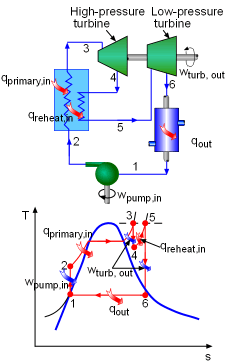 Schematic and T-s Diagram of an Ideal Reheat Rankine Cycle |
The Ideal Reheat Rankine Cycle
|
|
The above section states that increasing the boiler pressure can increase the thermal efficiency of the Rankine cycle, but it also increases the moisture content at the exit of the turbine to an unacceptable level. To correct this side effect, the simple Rankine cycle is modified with a reheat process. The schematic of an ideal reheat Rankine cycle is shown on the left with its T-s diagram. In this reheat cycle, steam is expanded isentropically to an intermediate pressure in a high-pressure turbine (stage I) and sent back to the boiler, where it is reheated at constant pressure to the inlet temperature of the high-pressure turbine. Then the steam is sent to a low-pressure turbine and expands to the condenser pressure (stage II) . The total heat input and total work output is qin = qprimary + qreheat = (h3 - h2) + (h5 - h4) wtotal, out = qturb, I + qturb, II = (h3 - h4) + (h5 - h6)
|
||
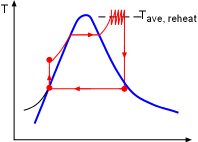 Multistage Reheat Approaching an Isothermal Process |
When the number of the reheat stages increases, the expansion and reheat processes approach an isothermal process at the maximum temperature. But using more than two stages is not practical.
|
|
